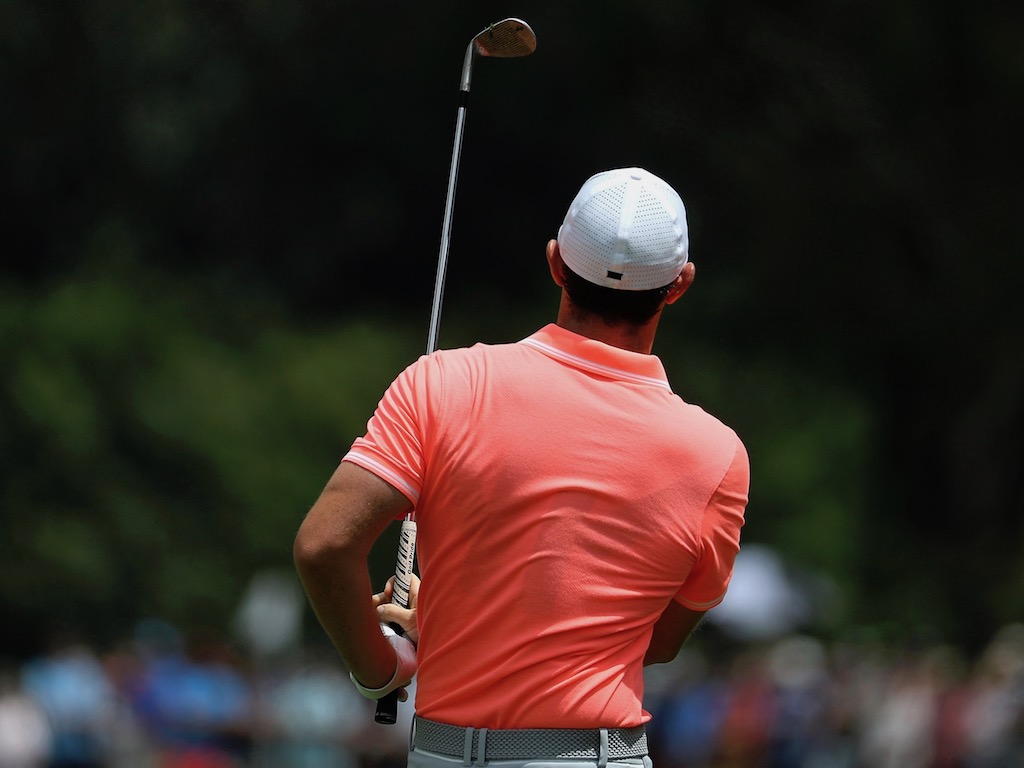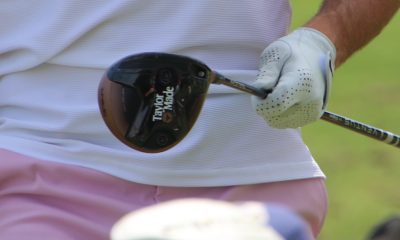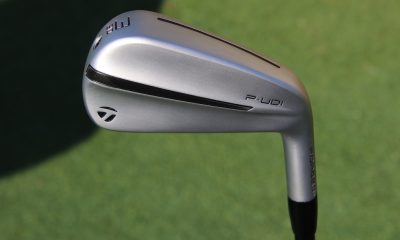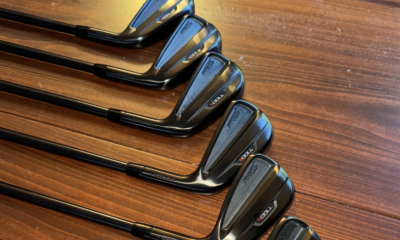Instruction
Tour Pros Revealed: 3 Tests to See How You Stack Up

You want to be better at golf, more consistent and longer off the tee. I am sure a lot of you would love to stop hurting. You would like these things with minimal work, if possible. You also want them yesterday. That about sum it up?
In the next 5 minutes, you’ll learn about the one thing that solves these problems for good. Before we dive in, though, I want to tee up three stats for you from my research.
- PGA Tour players can jump between 18-22 inches off the ground while LPGA Tour players can jump between 16-20 inches off the ground. Long drive competitors can often leap 30+ inches off the ground!
- Elite-level golfers who drive the ball 300+ yards can shot put a 6-pound ball more than 30 feet with less than a 5-percent difference in right-handed to left-handed throws.
- Elite golfers in the world can hurl a medicine ball with a seated chest pass just as far in feet as they can jump in inches (ie. a 20-inch vertical leap and a 20-foot seated chest pass).
What do these numbers have to do with you and your game? More importantly, what do these stats have to do with solving your problems? Let’s start by telling you what the solution is.
Objective Assessment and Intelligent Exercise Prescription
Say that three times fast. It’s a mouth full… But seriously, read it two more times and think about what that means.
It means that before you act on anything to improve your health or your game, you need to objectively assess what the problem is and get to the root cause. You should use quality objective data to arrive at intelligent health and golf improvement decisions based on the long-term likelihood that they will be successful. We can’t just select exercises, swing changes or training aids based on what is hot in the market today or what the latest celebrity was paid big bucks to sell to us.
There is a reason why the infomercials you see today on Golf Channel will be different in 2 months. The same gimmicks run out of steam when enough people realize that is what they are… gimmicks. When looking to achieve your goals of playing better golf and/or having less pain, don’t just grab for the quick fix as so many golfers today do.
We are in the information age. Information from quality data is power. Using this data intelligently, you can fix problems in a fraction of the time and at a fraction of the cost. Hopefully, I am giving you the power to make a meaningful and lasting change in your game. I’m sorry to say that most amateurs will not be hitting 300+ yard drives despite what the latest marketing ploy will have you believe. But, if you know what tests you can do to measure the areas that affect your distance off the tee, you can at least gain insight into where your biggest return on your time investment will be.
This is where working with a golf fitness expert can be so valuable to you. Not only can they help you interpret your results from the tests, but they will also be able to prescribe you the most effective means to move closer to 300 yards from where you are right now.
If you have a problem with your car not accelerating as fast as you would like or not being able to reach top end speed on the highway, I hope you take it to the mechanic and don’t just look up quick fixes on YouTube to see what you can do on your own. The reason you pay the mechanic to fix your car is because that is what they do all day. They will get it done as quickly as possible. More importantly, they’ll get correctly so that the problem doesn’t pop up again in 2 weeks.
A golf fitness expert is no different. Use them for their expertise and knowledge. Once you have a diagnosis of what is holding you back and a plan to correct it, you are on your way and won’t have to waste any more time or money trying silly quick fixes that never stick.
The three statistics mentioned earlier represent numbers measured across the globe by industry leaders and at our facility 3-4 times per year on hundreds of golfers each time. Our facility has thousands of data points. With this much data comes the ability to draw conclusions from objective assessments. These conclusions drive the intelligent implementation of successful solutions directed at the root causes of problems for thousands of golfers around the globe.
The first three statistics have an R-value of over 0.85 in correlation to clubhead speed. Translation: if you perform well in the first three tests with high numbers, you are very likely to have a high club speed. Further, if you improve in any of those three tests relative to where you started, you are almost assured to have a higher club speed than when you began (assuming swing technique and equipment is relatively unchanged).
Keep in mind that in statistics, correlation is not the same as cause and effect. But when the R-value is that close to 1 and anecdotally you have seen the results and changes we have, you put some weight behind these three tests. So:
- See how high you can jump
- See how far you can shot put a 6-pound medicine ball
- See how far you can chest pass a 6-pound medicine ball from a seated position
Doing so will give you an idea of how much power you have in your lower body, total rotary system and upper body respectively. Train whichever one is the worst, or train them all if you want. Rest assured that if you improve one of them, you will more than likely increase your swing speed.
By doing these assessments and addressing the one or two weak areas, you will improve with the least work possible. Sounds about what you were looking for, right? If you are able to identify where you need to improve BEFORE you buy whatever is claiming to fix your problems, you will save lots of money and time. You will actually start to improve with the least amount of work possible and in the least amount of time possible.
What’s next? After completing the assessment tests, start working to improve them.
- Upper Body Power for Golf
- Coming Soon: Lower Body Power for Golf
- Coming Soon: Rotary Power for Golf
- LIKE103
- LEGIT21
- WOW4
- LOL8
- IDHT1
- FLOP7
- OB1
- SHANK85
Instruction
The Wedge Guy: The easiest-to-learn golf basic

My golf learning began with this simple fact – if you don’t have a fundamentally sound hold on the golf club, it is practically impossible for your body to execute a fundamentally sound golf swing. I’m still a big believer that the golf swing is much easier to execute if you begin with the proper hold on the club.
As you might imagine, I come into contact with hundreds of golfers of all skill levels. And it is very rare to see a good player with a bad hold on the golf club. There are some exceptions, for sure, but they are very few and very far between, and they typically have beat so many balls with their poor grip that they’ve found a way to work around it.
The reality of biophysics is that the body moves only in certain ways – and the particulars of the way you hold the golf club can totally prevent a sound swing motion that allows the club to release properly through the impact zone. The wonderful thing is that anyone can learn how to put a fundamentally sound hold on the golf club, and you can practice it anywhere your hands are not otherwise engaged, like watching TV or just sitting and relaxing.
Whether you prefer an overlap, interlock or full-finger (not baseball!) grip on the club, the same fundamentals apply. Here are the major grip faults I see most often, in the order of the frequency:
Mis-aligned hands
By this I mean that the palms of the two hands are not parallel to each other. Too many golfers have a weak left hand and strong right, or vice versa. The easiest way to learn how to hold the club with your palms aligned properly is to grip a plain wooden ruler or yardstick. It forces the hands to align properly and shows you how that feels. If you grip and re-grip a yardstick several times, then grip a club, you’ll see that the learning curve is almost immediate.
The position of the grip in the upper/left hand
I also observe many golfers who have the butt of the grip too far into the heel pad of the upper hand (the left hand for right-handed players). It’s amazing how much easier it is to release the club through the ball if even 1/4-1/2″ of the butt is beyond the left heel pad. Try this yourself to see what I mean. Swing the club freely with just your left hand and notice the difference in its release from when you hold it at the end of the grip, versus gripping down even a half inch.
To help you really understand how this works, go to the range and hit shots with your five-iron gripped down a full inch to make the club the same length as your seven-iron. You will probably see an amazing shot shape difference, and likely not see as much distance loss as you would expect.
Too much lower (right) hand on the club
It seems like almost all golfers of 8-10 handicap or higher have the club too far into the palm of the lower hand, because that feels “good” if you are trying to control the path of the clubhead to the ball. But the golf swing is not an effort to hit at the ball – it is a swing of the club. The proper hold on the club has the grip underneath the pad at the base of the fingers. This will likely feel “weak” to you — like you cannot control the club like that. EXACTLY. You should not be trying to control the club with your lower/master hand.
Gripping too tightly
Nearly all golfers hold the club too tightly, which tenses up the forearms and prevents a proper release of the club through impact. In order for the club to move back and through properly, you must feel that the club is controlled by the last three fingers of the upper hand, and the middle two fingers of the lower hand. If you engage your thumbs and forefingers in “holding” the club, the result will almost always be a grip that is too tight. Try this for yourself. Hold the club in your upper hand only, and squeeze firmly with just the last three fingers, with the forefinger and thumb off the club entirely. You have good control, but your forearms are not tense. Then begin to squeeze down with your thumb and forefinger and observe the tensing of the entire forearm. This is the way we are made, so the key to preventing tenseness in the arms is to hold the club very lightly with the “pinchers” — the thumbs and forefingers.
So, those are what I believe are the four fundamentals of a good grip. Anyone can learn them in their home or office very quickly. There is no easier way to improve your ball striking consistency and add distance than giving more attention to the way you hold the golf club.
More from the Wedge Guy
- The Wedge Guy: Golf mastery begins with your wedge game
- The Wedge Guy: Why golf is 20 times harder than brain surgery
- The Wedge Guy: Musings on the golf ball rollback
- LIKE85
- LEGIT13
- WOW6
- LOL1
- IDHT0
- FLOP4
- OB1
- SHANK8
Instruction
Clement: Stop ripping off your swing with this drill!

Not the dreaded headcover under the armpit drill! As if your body is defective and can’t function by itself! Have you seen how incredible the human machine is with all the incredible feats of agility all kinds of athletes are accomplishing? You think your body is so defective (the good Lord is laughing his head off at you) that it needs a headcover tucked under the armpit so you can swing like T-Rex?
- LIKE0
- LEGIT2
- WOW2
- LOL0
- IDHT0
- FLOP0
- OB0
- SHANK2
Instruction
How a towel can fix your golf swing

This is a classic drill that has been used for decades. However, the world of marketed training aids has grown so much during that time that this simple practice has been virtually forgotten. Because why teach people how to play golf using everyday items when you can create and sell a product that reinforces the same thing? Nevertheless, I am here to give you helpful advice without running to the nearest Edwin Watts or adding something to your Amazon cart.
For the “scoring clubs,” having a solid connection between the arms and body during the swing, especially through impact, is paramount to creating long-lasting consistency. And keeping that connection throughout the swing helps rotate the shoulders more to generate more power to help you hit it farther. So, how does this drill work, and what will your game benefit from it? Well, let’s get into it.
Setup
You can use this for basic chip shots up to complete swings. I use this with every club in my bag, up to a 9 or 8-iron. It’s natural to create incrementally more separation between the arms and body as you progress up the set. So doing this with a high iron or a wood is not recommended.
While you set up to hit a ball, simply tuck the towel underneath both armpits. The length of the towel will determine how tight it will be across your chest but don’t make it so loose that it gets in the way of your vision. After both sides are tucked, make some focused swings, keeping both arms firmly connected to the body during the backswing and follow through. (Note: It’s normal to lose connection on your lead arm during your finishing pose.) When you’re ready, put a ball in the way of those swings and get to work.

Get a Better Shoulder Turn
Many of us struggle to have proper shoulder rotation in our golf swing, especially during long layoffs. Making a swing that is all arms and no shoulders is a surefire way to have less control with wedges and less distance with full swings. Notice how I can get in a similar-looking position in both 60° wedge photos. However, one is weak and uncontrollable, while the other is strong and connected. One allows me to use my larger muscles to create my swing, and one doesn’t. The follow-through is another critical point where having a good connection, as well as solid shoulder rotation, is a must. This drill is great for those who tend to have a “chicken wing” form in their lead arm, which happens when it becomes separated from the body through impact.
In full swings, getting your shoulders to rotate in your golf swing is a great way to reinforce proper weight distribution. If your swing is all arms, it’s much harder to get your weight to naturally shift to the inside part of your trail foot in the backswing. Sure, you could make the mistake of “sliding” to get weight on your back foot, but that doesn’t fix the issue. You must turn into your trial leg to generate power. Additionally, look at the difference in separation between my hands and my head in the 8-iron examples. The green picture has more separation and has my hands lower. This will help me lessen my angle of attack and make it easier to hit the inside part of the golf ball, rather than the over-the-top move that the other picture produces.


Stay Better Connected in the Backswing
When you don’t keep everything in your upper body working as one, getting to a good spot at the top of your swing is very hard to do. It would take impeccable timing along with great hand-eye coordination to hit quality shots with any sort of regularity if the arms are working separately from the body.
Notice in the red pictures of both my 60-degree wedge and 8-iron how high my hands are and the fact you can clearly see my shoulder through the gap in my arms. That has happened because the right arm, just above my elbow, has become totally disconnected from my body. That separation causes me to lift my hands as well as lose some of the extension in my left arm. This has been corrected in the green pictures by using this drill to reinforce that connection. It will also make you focus on keeping the lead arm close to your body as well. Because the moment either one loses that relationship, the towel falls.


Conclusion
I have been diligent this year in finding a few drills that target some of the issues that plague my golf game; either by simply forgetting fundamental things or by coming to terms with the faults that have bitten me my whole career. I have found that having a few drills to fall back on to reinforce certain feelings helps me find my game a little easier, and the “towel drill” is most definitely one of them.
- LIKE12
- LEGIT2
- WOW2
- LOL0
- IDHT0
- FLOP2
- OB0
- SHANK8
-

 19th Hole1 week ago
19th Hole1 week agoDave Portnoy places monstrous outright bet for the 2024 Masters
-

 19th Hole2 weeks ago
19th Hole2 weeks agoThings got heated at the Houston Open between Tony Finau and Alejandro Tosti. Here’s why
-

 19th Hole1 week ago
19th Hole1 week agoTiger Woods arrives at 2024 Masters equipped with a putter that may surprise you
-

 19th Hole2 weeks ago
19th Hole2 weeks agoReport: Tiger Woods has ‘eliminated sex’ in preparation for the 2024 Masters
-

 19th Hole3 days ago
19th Hole3 days agoTwo star names reportedly blanked Jon Rahm all week at the Masters
-

 19th Hole3 days ago
19th Hole3 days agoNeal Shipley presser ends in awkward fashion after reporter claims Tiger handed him note on 8th fairway
-

 19th Hole2 weeks ago
19th Hole2 weeks agoAddiction, spinal fusion, and scam artists – Everything Anthony Kim revealed in candid interview with David Feherty
-

 19th Hole2 weeks ago
19th Hole2 weeks agoAnthony Kim says doctors told him that he ‘may not have much time left’ ahead of LIV return

























Brian
Jan 14, 2018 at 7:07 pm
So what you’re saying is that you don’t have to be a great athlete to be a pro golfer?
RBimGuy
Jan 14, 2018 at 9:34 pm
No, he’s saying you can be a make-believe pro golfer if you play PXGs.
It’s all in the clubs you play.
The dude
Jan 14, 2018 at 3:26 pm
Nice article Chris…..those that didn’t like the article are likely the same people that think distance can be bought off the shelf (new driver)….rather than changing their physical abilities…….
….take heed lazy people…..take heed…
RBimGuy
Jan 14, 2018 at 9:36 pm
You got that right. It’s all in the head and not in the body.
Gearheads with fantastic WITB clubs play fantasy golf on golf forums.
So obvious
Chris Finn
Jan 22, 2018 at 8:00 am
Thanks The dude, glad you saw the value in the information.
Philip
Jan 14, 2018 at 1:00 pm
The more important question is how you decided to draw the correlation between your chosen three stats and golf results … yes, everyone knows that overall health will benefit any physical and mental activity – but to make a direct causality may be a bit of a stretch. Besides, my longest ever drives was after I had a case of food poisoning and could barely stand or hold the golf club for a stretch of a few days. Once I got my strength back my yardages reduced to my normal averages … hmmm ….
Chris Finn
Jan 22, 2018 at 8:11 am
Thanks for the comment Philip. There is no causality suggested, it is a correlation with an r value of 0.87. Scientifically speaking, swing speed is a power measure (speed + force = power). The tests were chosen as they are representative of power output in the three main areas of power generation. Hope this helps!
RBImGuy
Jan 14, 2018 at 3:34 am
I know a 60 year old that can hit 350+ being unfit, weak in all 3 tests.
Go figure
DaJudge
Jan 14, 2018 at 1:02 pm
I know a “Guy” who lies just to get a raise from people on golf forums.
Believe it
The dude
Jan 14, 2018 at 3:21 pm
…..so your saying there are exceptions…..thanks for that.
RBimGuy
Jan 14, 2018 at 9:31 pm
My bad….. correction:
I know a 60 year old that can hit 150+ being unfit, weak in all 3 tests.
Go figure
Joe
Jan 14, 2018 at 2:16 am
Except that it was the wedge game that took Dustin Johnson from good PGA Tour golfer to #1 in the world. Power is great, but distance control from 100 yards and in, as well as putting, will always trump distance.
Someone
Jan 14, 2018 at 10:13 am
Sure, but I believe the article is geared towards making amateurs better, not tour pros. As an amateur, even if your wedge game was #1 in the world, it wouldn’t matter if you can’t play from the pro tees. Given all stats the same between two players, driving, long game, short game, scramble, putting…but one of them excelled at short game more than the other, then your statement is absolutely true. As this article is aimed at amateurs seeking to find ways to increase their abilities and game, your statement is a moot point. There is no amateur in the game that could not benefit from this…not one. Heck, there are even pros that could benefit from this information.
RBimGuy
Jan 14, 2018 at 9:40 pm
If it’s not good for tour pros it’s not good enough for me.
I’m special even though I can’t hit a snot
Someone
Jan 15, 2018 at 1:25 pm
Of course his wedge game got him there…every drive was practically within wedge distance for second shot. What got him to within wedge distance? The drive. Now if he hit all the greens in regulation with his mid irons and not his wedges…you gonna still say his wedges are what won him the tournament, or his second shot/approach shot ability is what won it for him?
luke
Jan 17, 2018 at 5:03 pm
Look where the top 10 drivers of the ball sit in the world rankings and look where the top 10 wedge players and putters sit. simple if you can drive the ball to the best possible wedge position every time your wedge game will be better than the guy who is hitting 7 iron in every day.
SK
Jan 13, 2018 at 11:00 pm
Excellent!!! I look forward to your next 3 articles on ‘power’ because each body segment is part of the kinetic chain from the ground up to the shoulders.
RBimGuy
Jan 14, 2018 at 9:38 pm
So yer saying that golfers are in chains up to the shoulders?
Sounds about right.